Longest Walk 5: War on Drugs About More Than Drug Abuse
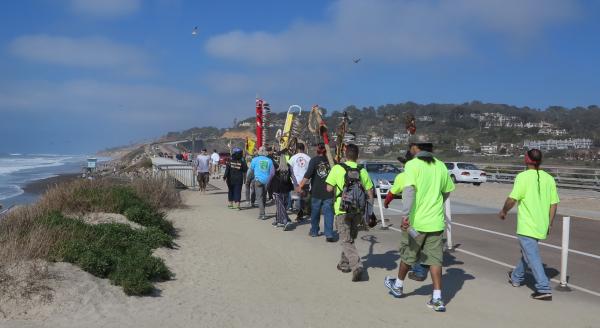
Nanette Deetz
While surfers lined up on the shore and contemplated waves, a group of some 100 American Indians gathered nearby at the La Jolla Shores beach front park for the beginning of the Longest Walk 5: War on Drugs.
“We are gathered here today to… bring attention to the problems of drug abuse so prevalent on all of our reservations and urban communities today. We also intend to bring attention to the problems of domestic violence which are often made worse when drugs are involved,” event organizer and co-founder of the American Indian Movement Dennis Banks, Ojibwe, said to those gathered. “Many of us, including myself have experienced drug abuse within our own families, as well as domestic violence. I have spoken to women who have been dealing with domestic violence for generations. This must stop. We want to gather valuable input from each of the Indian communities we walk through in order to find solutions. We also want to push for a change in our criminal justice system that does not criminalize minor drug offenses, so that our youth are not incarcerated in such high numbers.”
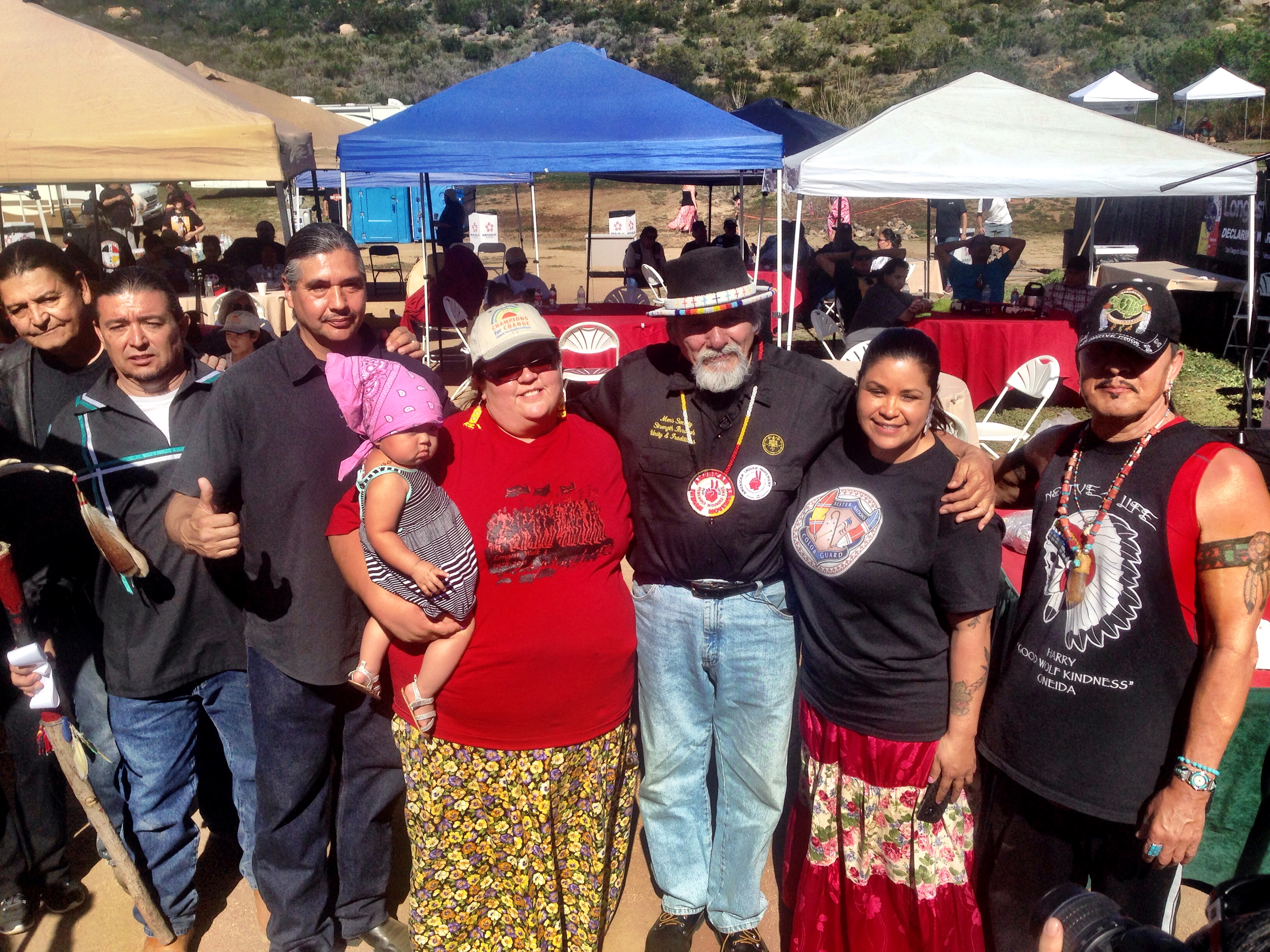
The beachfront park where walkers gathered is named for the La Jolla Band of Mission Indians. The community of La Jolla today is an extremely wealthy neighborhood of mostly white citizens. The juxtaposition of many Native peoples gathered on this beach, ready to walk hundreds of miles to stop drug abuse among their largely poor communities, was striking. Most of those gathered were there to surf and enjoy the water. It seemed like a very good learning experience for the non-Natives gathered waiting to surf, to realize that their privileged reality is only a very small part of most Americans experience.
RELATED: Dennis Banks Declares War on Drugs with Longest Walk 5
There was a small issue in obtaining a permit for the walkers to pass through Torrey Pines National Park located in La Jolla. The national organizer, Orland Vigil had to reach out to tribal chiefs in the area to obtain the necessary permits. Apparently the Park Service had forgotten whose land they presently occupy, as so often happens for California tribal people in their own state.
The Longest Walk 5: War on Drugs traveled along the southern route out of the state, which includes the large casino resort tribal nations that first signed gaming contracts with the state of California. Those tribal groups who helped host the walkers included the Pala, Pechanga, the Barona, the Morongo, the La Jolla Band of Mission Indians, Soboba Band of Mission Indians, Torres Martinez Band of Mission Indians, the Sycuan, and Viejas Bands among others. The San Diego tribes offered support to the walkers with lodging, food, gas money, places to stay, and whenever their political clout was needed, it was given, as in the case of tribal chiefs speaking with the Torrey Pines National Park service.
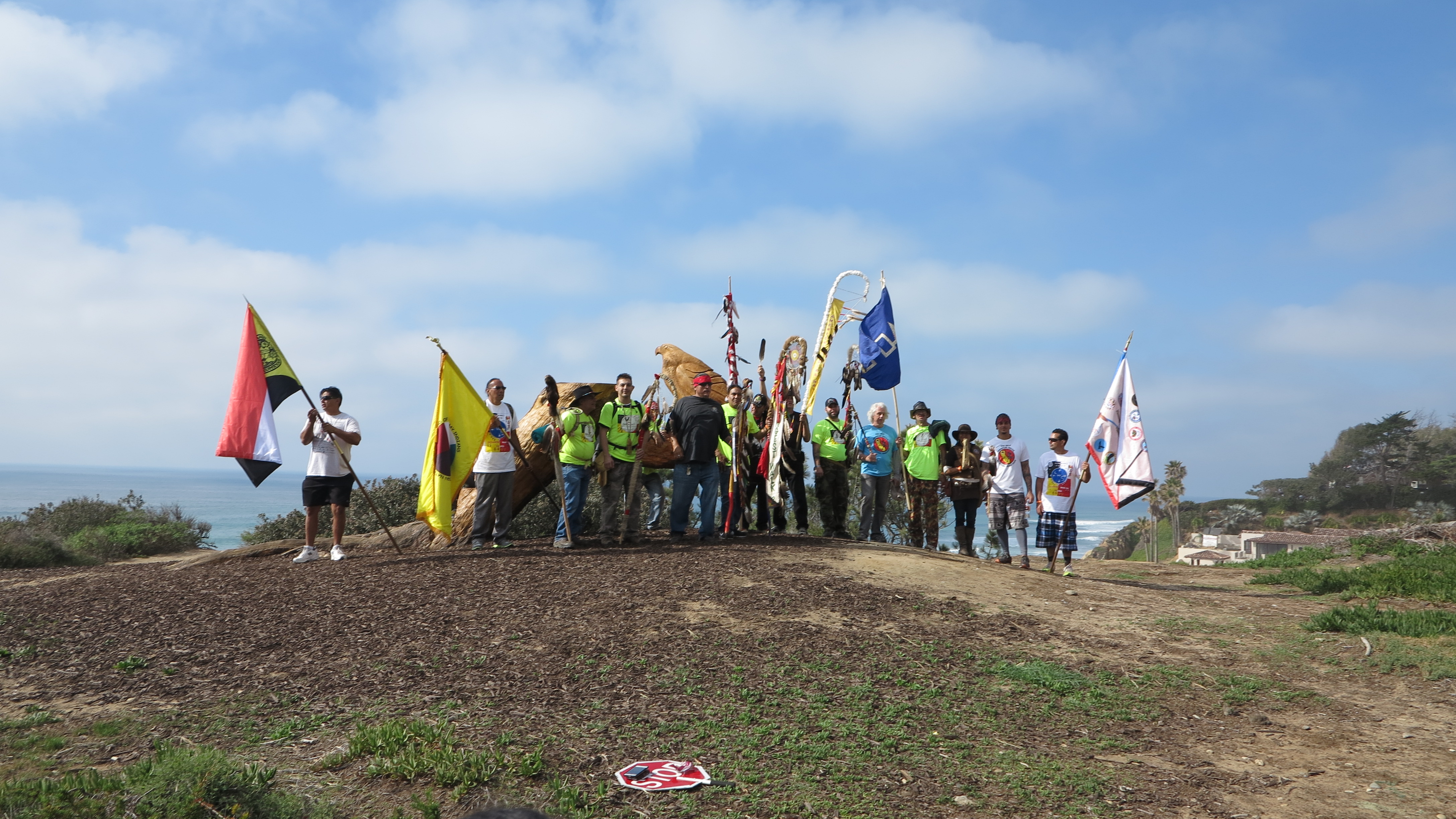
Although this Longest Walk 5 is entitled, “War on Drugs” it became clear that economics of survival is still one of the greatest causes of drug abuse and domestic violence. Many experts have written and gathered statistics that point out that poverty itself is a form of violence. When an entire group of people are forced onto either reservations or ghettos, it becomes easy for those who have an interest in preying on them to do so. Drug abuse is prevalent when jobs are scarce, and there is nothing to engage youth. Domestic violence often occurs out of frustration from poverty.
Economics has clearly changed in these communities for the better in the last 20 years. The last time this writer visited many of these communities was in the late 1960s when the level of poverty was the worst in any part of the United States. It was difficult to even find a good road in which to reach these communities, they were so isolated from the white mainstream on the coast. Things have definitely improved since then.
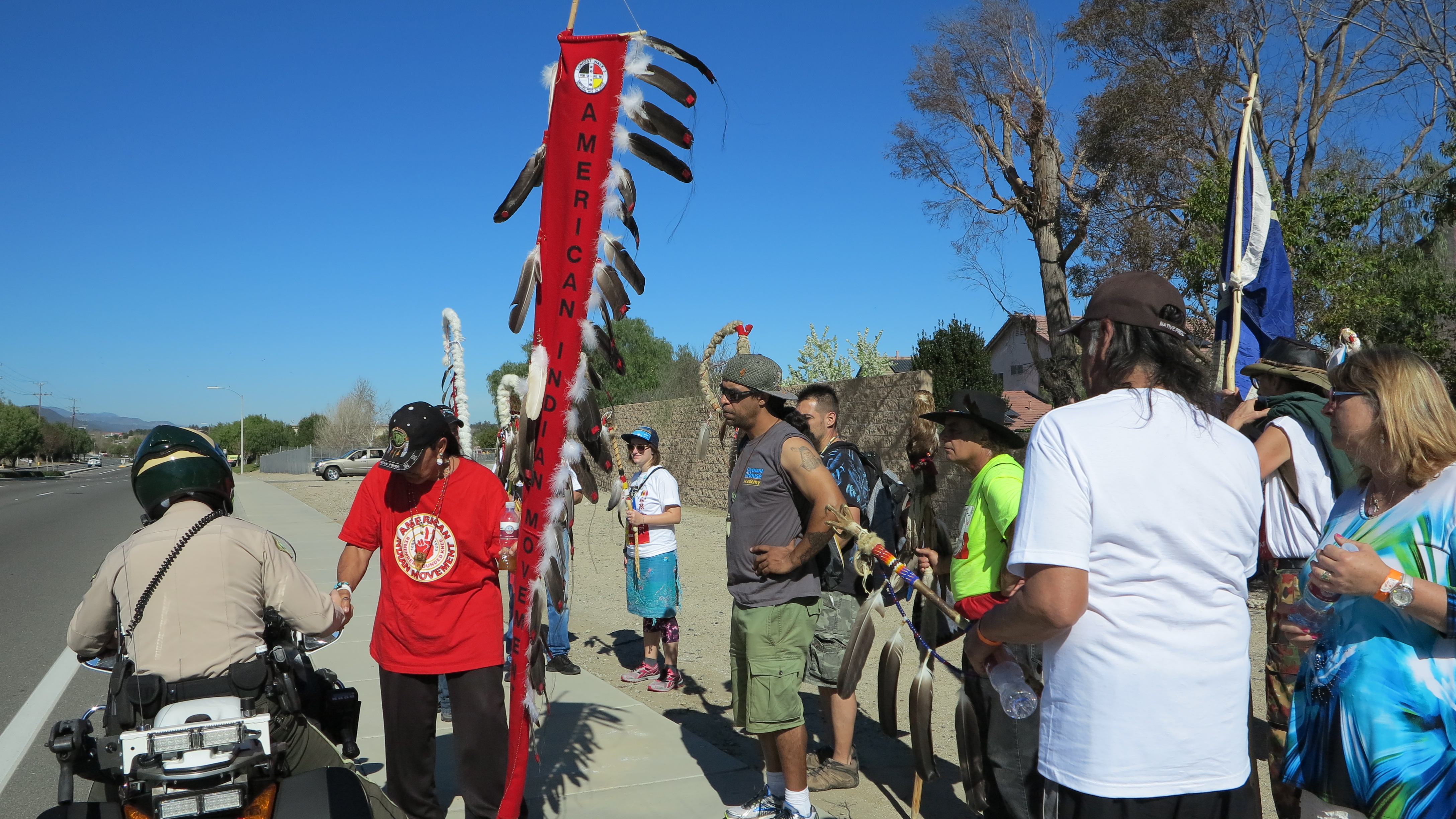
“I’ve watched life and economics change. Rez life is the same everywhere. It's a different life from the mainstream. Now, with all the extreme amounts of money flowing from casinos, young people are able to buy drugs, toys, engage in all the destructive behavior the white, settler-colonials have developed and push on us through their media. It is a terrible tragedy", said Silas Batisse, of the Barona Indian Reservation.
“People are now turning to culture, tradition, and spirituality in order to save our people. You really must feel the pain of your kids and family abusing drugs before you can understand. What can you do? All we have is our prayers. All I can do is to pray for them", said Wounded Knee DeOcampo, who has attended every Longest Walk since the first one in 1978. “The purpose of this walk is to bring attention about Native Americans and all that we are suffering as a result of this genocide. We cannot let this happen anymore. When we (the elders) are gone, who will take care of the land, the culture, the people? We are in a spiritual war. We are fighting for our very survival as a distinct group of indigenous people.”
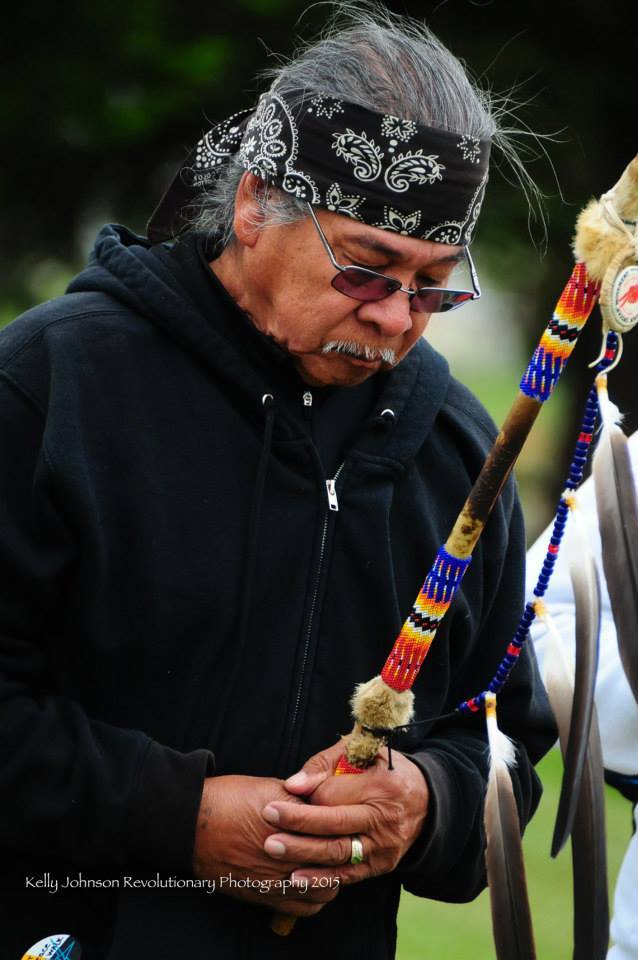
RELATED: Miwok Elder Participating in His Fifth Longest Walk
The purpose of this walk is to bring in and involve Native youth so they have other things to get involved in besides drugs and destructive behaviors. Banks reminded those on the walk that this particular walk is personal for him.
“My daughters and sons were using alcohol and drugs while at my own home. For years I didn’t want to see it. I was in a very deep denial. However, we don’t want a justice system that treats our youth as criminals either,” Banks said. “Part of this walk is to push for de-criminalization of marijuana. It is now legal in many states as a medicinal treatment for many illnesses. It is also now being grown on several Indian reservations, along with hemp. We need to make sure that our youth and all our people are protected from criminal prosecution before we jump into this next ‘cash cow.’ We should not trust this government to not attempt to trick us again. By now, we should know better. I know that some of our elders are forced to sell their prescription drugs in order to buy food. This should not be accepted. It is intolerable. I believe we as Native peoples know the difference between a drug and a medicine used for spiritual cleansing. We do not confuse or abuse this knowledge. Also, the problem of domestic violence needs to be addressed in all of our communities. Our women have been suffering from this problem for many generations. I don’t know where this kind of violence began, but I do remember that in the 1940s they showed us movies in the boarding schools where men were beating their wives. Also, if you go to a video arcade today, at least half of the games are about killing other human beings. This then becomes an accepted way of life. I know that we never experienced this level of violence before 1492. It is time to finally end it. It needs to be rejected completely by our people, and we need to teach our young men another way of defining masculinity. This way is wrong.”

The walk intends to follow a southern route through the United States, ending in Washington, D.C. by July 15, 2016. Banks has promised to bring the walkers to Oak Flats in Arizona in order to support the Apache in their struggles to protect their sacred site. For those interested in joining the walk, the itinerary is posted on the Longest Walk 5: War on Drugs Facebook page. The greatest outcome of this Longest Walk would be a real dialogue and discussion about why a supposedly “democratic” government feels the need to still isolate an entire race and culture. Many Natives feel this is a good thing in order to have sovereignty. Others feel that this was and is a genocidal policy, aimed at creating poverty and damaging family structures.
Americans need to learn the truth about their own history as a settler-colonial system based on genocide and slavery. They need to know that this system practices a form of apartheid that is no different than that of South Africa, and come out of its deep historic denial. Until that happens, racism and division will continue, because each new generation is told the same lies. Drug abuse, poverty, and destructive behaviors are all symptoms of the larger problem associated with a system built upon genocide. Unless these problems are addressed, the American tradition of blaming the victim will continue, and those most degraded by drug abuse will continue to be held personally responsible.
Banks intends to walk as far and as often as possible in order to bring this to the attention of those in power and to those in all of our indigenous communities. He will be asking for input and possible solutions in each and every community visited on this walk. Hopefully, this will show those in political power in Washington, D.C. that we are extremely serious and will speak loudly and clearly for our nations.
Read more at http://indiancountrytodaymedianetwork.com/2016/03/04/longest-walk-5-war-drugs-about-more-drug-abuse-163566